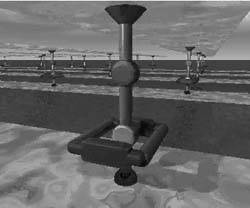Integration
| The human benefit of advances in nanotechnology will stem from the transition from handling single nanoparticles to realizing large-scale manufacturing capabilities. Spanning from the nanoscale to the macroscale is a necessary process in the transition of the nanosciences into industry. Artificial fabrication technologies are usually considered top-down, meaning that they involve manipulations at the macroscale, such as cutting or etching bulk materials. Nature, on the other hand, relies on bottom-up fabrication, involving molecule-by-molecule assembly to create a predesigned subject. Thus, the goal of artificial bottom-up fabrication involves the directed and orderly integration of molecules at the nanoscale to form a macroscale device. An example of bottom-up fabrication is the self-assembling monolayer (SAM) used by chemists (Ulman 1991, 1995), such as the attachment of nano-sized motor molecules to cantilever beams to form actuators. Rotaxane, a motor molecule shown in Figure 17-5, has two separate recognition sites, each associated with a different energy potential. Placing the rotaxane molecule in an oxidant oxidizes one site, thereby raising the energy level associated with the site (Collier 1999). As a consequence, the energy profile of the rotaxane molecule is altered so that the ring prefers association with the other recognition site, thereby causing the ring to move. Applying a reductant will return the energy profile to its original state, forcing the ring back to its original position. In this way, a molecular motor is created. This is an example of how to use artificial self-assembly to integrate atoms into a molecular system. Figure 17-5. Graphical representation of a rotaxane molecule. Alternating oxidation and reduction of the molecule results in movement of the ring structures (Collier et al. 1999). The rotaxane molecule was further modified to create a molecule containing two rings and four recognition sites. Anchoring the two rings to a gold surface creates a molecular muscle that, when placed in an oxidant, causes the two rings to move to the center of the molecule and bend the beam, a movement that can be detected by a laser beam. An array of molecular muscles attached to cantilever beams was created, as shown in Figure 17-6. Alternating the application of oxidant and reductant causes the beam to bend upward and return to its original position. This experiment illustrates how we combine the top-down and the bottom-up fabrication techniques to form an integrated micromechanical system from the nanoscale integrated system. Figure 17-6. A microcantilever beam activated by nanoscale motor molecules (Huang et al. 2004). |
EAN: 2147483647
Pages: 204

